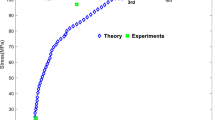Abstract
Dislocation dynamics simulations often reveal interesting phenomena in regard to material deformation, which may not be captured by experiments. In this work, we investigate the effect of dislocation dipoles on plastic material properties under different dipole configurations (i.e. the distance between active glide planes, and the signs of the two dislocations) using a 3D Discrete Dislocation Dynamics code. The simulations show that a dipole is causing a hardening effect when the Burgers vectors of the dislocations forming the dipole are of opposite sign and causing a hardening/softening effect when they are of the same sign. The distance between the two neighboring dislocations was also affecting the proportional limit for the material. Such hardening or flow stress results, as in this study, can be incorporated in larger-scale modeling work.
Access this chapter
Tax calculation will be finalised at checkout
Purchases are for personal use only
Similar content being viewed by others
References
Zbib H, Rhee M, Hirth J, Rubia TDL (1998) On dislocation reactions and hardening mechanisms in 3D dislocation dynamics. MRS Online Proc Libr Arch 538
Stokes RJ, Olsen KH (1963) Dislocation interactions and dipole formation. Phil Mag 8:957–965
Kroupa F (1996) Dislocation dipoles and dislocation loops. Le J de Phys Colloques 27(c3)
Gilman JJ (1964) Influence of dislocation dipoles on physical properties. R Soc Chem 38
Neumann PD (1971) Interactions between dislocations and dislocation dipoles. Acta Metall 19(11):1233–1241
Kubin LP, Canova G, Condat M, Devincre B, Pontikis V, Brechet Y (1992) Dislocation microstructures and plastic flow: a 3D simulation. Solid State Phenom 23–24:455–472
Zbib HM, Rhee M, Hirth JP (1998) On plastic deformation and the dynamics of 3D dislocations. Int J Mech Sci 40(2–3):113–127
de la Rubia TD, Zbib HM, Khraishi TA, Wirth BD, Victoria M, Caturla MJ (2000) Multiscale modelling of plastic flow localization in irradiated materials. Nature 406(6798):871–874
Khraishi TA, Zbib HM, de la Rubia TD, Victoria M (2002) Localized deformation and hardening in irradiated metals: three-dimensional discrete dislocation dynamics simulations. Metall Mater Trans B 33(2):285–296
Siddique AB, Khraishi T (2020) Numerical methodology for treating static and dynamic dislocation problems near a free surface. J Phys Commun 4(5):055005
Hirth JP, Lothe J (1982) Theory of dislocations. Wiley, Hoboken
Bacon DJ, Hull D (2011) Introduction to dislocations, Butterworth-Heinemann
Acknowledgements
This paper describes objective technical results and analysis. Any subjective views or opinions that might be expressed in the paper do not necessarily represent the views of the U.S. Department of Energy or the United States Government.
Sandia National Laboratories is a multi-mission laboratory managed and operated by National Technology and Engineering Solution of Sandia, LLC., a wholly owned subsidiary of Honeywell International, Inc., for the U.S. Department of Energy’s National Nuclear Security Administration under contract DE-NA0003525.
Author information
Authors and Affiliations
Corresponding author
Editor information
Editors and Affiliations
Rights and permissions
Copyright information
© 2021 The Minerals, Metals & Materials Society
About this paper
Cite this paper
Siddique, A.B., Khraishi, T., Lim, H. (2021). Dislocation Dipole Study on Material Hardening/Softening. In: TMS 2021 150th Annual Meeting & Exhibition Supplemental Proceedings. The Minerals, Metals & Materials Series. Springer, Cham. https://doi.org/10.1007/978-3-030-65261-6_46
Download citation
DOI: https://doi.org/10.1007/978-3-030-65261-6_46
Published:
Publisher Name: Springer, Cham
Print ISBN: 978-3-030-65260-9
Online ISBN: 978-3-030-65261-6
eBook Packages: Chemistry and Materials ScienceChemistry and Material Science (R0)




